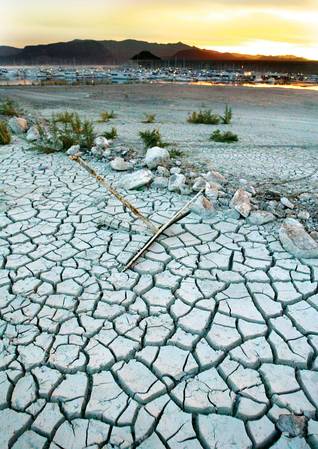
Aaron Mayes / AP
Monday, April 6, 2015 | 2 a.m.
A century from now, the Las Vegas Valley could be shrouded in a haze of ozone, parched from lengthy droughts and faced with blackouts from overexerted power grids used to run air conditioners. Summer temperatures could rise, and hotter days and warmer nights could disrupt Nevada’s ecosystem.
Climate change is altering our planet, with devastating results. One hundred years from now, the effects of our reliance on fossil fuels could be paralyzing.
Projecting the impact of climate change is a cloudy business, but the world’s leading climate scientists agree that global warming is happening and stopping it will require reducing greenhouse gas emissions, possibly to zero, this century.
“Science has spoken. There is no ambiguity in their message. Leaders must act. Time is not on our side,” U.N. Secretary-General Ban Ki-moon said during the release last year of an Intergovernmental Panel on Climate Change report.
Already as a result of climate change, sea levels are rising, the ocean is becoming warmer and more acidic, glaciers are melting, and heat waves are becoming more frequent and intense.
What’s coming down the pike? Here is a look at what life in the valley could be like 100 years from now if global warming continues unfettered.
Weather
Over the next century, the average temperature in Southern Nevada is expected to rise between 2.5 and 8 degrees. That means July temperatures could measure as high as 123 degrees.
And weather patterns considered extreme today are expected to become the norm. One hundred-plus degree days will occur more frequently, droughts will last longer and monsoon rainstorms will become more intense, scientists say.
Health
A haze of ozone could settle into the valley.
For now, Las Vegas sits on the safe side of the Environmental Protection Agency’s ozone standards, but a string of longer summers and heat waves that help ozone thrive could create a health hazard.
Ground-level ozone can exacerbate respiratory issues. Prolonged exposure is powerful enough to crack rubber tires, and breathing it can destroy lung tissue, which can be especially dangerous for children.
Because ozone can travel with wind, high levels would be a regional problem that would require an unprecedented multijurisdictional plan to resolve.
Lake Mead
Higher temperatures almost certainly would mean less water in Lake Mead. Minerals that typically get diluted in the lake, such as salt, would become more concentrated, making the water undrinkable and threatening native fish.
In Northern Nevada’s Pyramid Lake, the water level dropped, killing the Lahontan trout to near extinction. The same could happen to Lake Mead and the Colorado River’s razorback sucker, Colorado pikeminnow and bonytail chub.
Flora and fauna
A rapidly changing environment could lead to a proliferation of invasive species. Already, cheatgrass and salt cedar trees have moved in, killing off once-populous willow trees and leaving the willow flycatcher bird without a habitat.
Drier conditions could make forest fires more frequent, intense and unpredictable.
Infrastructure
Frequent heat waves and higher temperatures could overexert air conditioning units and fry power grids, causing increased blackouts and power failures.
Not just Nevada
The effects of climate change are expected to affect every part of the country.
Northwest and Alaska
● Higher water temperatures could cause some fish species, including Pacific Northwest salmon, to migrate northward.
● Sea level rise could affect low-lying areas, especially in the Puget Sound area.
● Warming in Alaska could increase permafrost thawing, damaging roads and buildings.
Midwest/Great Plains
● Winters could become milder.
● Droughts and flash flooding could increase.
● The growing season could become longer, but farming on marginal land could become more difficult.
Southwest
● Deserts could shrink, while shrublands could expand.
● Changes in wet and dry periods could increase flooding and fires.
● Some birds and mammal species could move to higher elevations, while reptiles and amphibians could stay in lower elevations, disrupting the food chain.
Mountain West
● Reduced snow accumulation in the mountains could result in less summer runoff, complicating water management, flood control and irrigation.
● Alpine meadows in the Rocky Mountains could disappear.
Great Lakes
● Water levels could decrease because of increased evaporation.
● Marine transportation problems could emerge because of lower water levels.
● Invasive species could proliferate.
Northeast
● Warming could cause more rain and flooding.
● Higher temperatures could exacerbate pollution from agricultural runoff.
● Maple trees could disappear.
● Coastal cities could have to reroute sewer, water and transportation systems to accommodate a rise in sea level.
Southeast
● Rising sea levels and more frequent storm surges could threaten coastal development.
● Coastal wetlands, barrier islands and beaches could disappear.
● Grassland and savannas could displace forests.
Islands
● Sea level rise could reduce the availability of fresh water and pose health risks.
● Higher water temperatures and increased carbon dioxide levels could exacerbate coral bleaching and increase destruction of coral reefs off southern Florida and the Hawaiian Islands.
Sources: Western Regional Climate Center, Clark County Department of Air Quality, CBS, Desert Research Institute, Associated Press, Native American Community Development Corporation

Join the Discussion:
Check this out for a full explanation of our conversion to the LiveFyre commenting system and instructions on how to sign up for an account.
Full comments policy